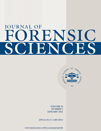Amussat’s Sign in Hanging—A Prospective Autopsy Study
Abstract
Abstract: Amussat’s sign is typically a transverse laceration of the intimal layer of carotid arteries described in cases of hanging. Subtotal laceration of the carotid artery is not strictly specific for hanging and can be also caused by blunt neck trauma, extreme overstretching, or whiplash-injuries. In a prospective autopsy study of 178 cases of hanging, Amussat’s sign was found in 29 cases (a relative frequency of 16.1%). A statistically significant association between the occurrence of tears in the intimal layer of carotid arteries and the victims’ age was discovered in the cases studied (the frequency increased with age; p < 0.05). The occurrence of Amussat’s sign was independent of gender, weight, completeness of the victim’s body suspension, and position of the ligature knot on the neck. The study demonstrates the fact that the most probable cause of Amussat’s sign is a combination of direct compression of the artery by the rope and indirect stretching because of the gravitational drag produced by the weight of the body.




